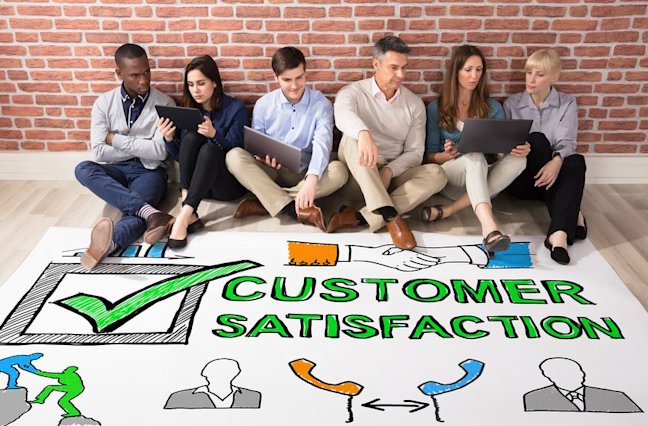Transform data into smarter decisions with AI data analytics
Discover how AI data analytics unlocks insights from customer interactions, driving smarter decisions, growth, and competitive advantage.
Solutions
Products
Ingest omnichannel customer interactions, from audio and screens to surveys, for complete visibility and analytics.
AI virtual agents, real-time multilingual translation, and event-based customer feedback drive smarter, personalized CX initiatives.
Customers
Solutions
Products
Customers
Resources
Company
The Team at CallMiner
January 27, 2020


CSAT (Customer Satisfaction) is a measurement used to quantify the degree to which customers are satisfied with a service, product or experience. In most cases, the term “CSAT” is used in connection with “CSAT score,” which refers to the numerical measure of customer satisfaction. Brands and marketers use CSAT scores to establish a customer’s level of satisfaction at specific interaction times along the customer journey, such as during a support ticket exchange, the moment of purchase, a phone conversation with customer service, or during the onboarding process.
If you don’t calculate customer satisfaction, you won’t identify whether you have satisfied customers or customer success. And if you don’t know which customers are less-than-satisfied, you can’t identify the customers who are most likely to churn. You also can’t establish why they’re unhappy, meaning you can’t take action aimed at resolving their issues and improving their overall omnichannel customer experience. If your customers churn faster than you can acquire new customers, your business is in trouble. According to Forbes, organizations lose $338.5 billion per year globally due to bad customer service.
Without contact and feedback from a customer, you isolate yourself in a bubble. Top-performing businesses will always remain elite because they often measure customer satisfaction scores and act upon the data gathered.
The main reason why businesses measure customer satisfaction is retention, a crucial factor in long-term business growth. You could acquire customers rapidly, but if they don’t stick around long enough to give you repeat business, then you won’t have a sustainable business. Customer retention impacts all aspects of a business, from the costs of customer acquisition to customer loyalty and customer lifetime value.
Now that we’ve established the importance of customer satisfaction, let’s take a look at how to measure it.
The primary objective for any business should be creating satisfied customers. Businesses that measure customer satisfaction, or customer effort scores, grow and flourish, whereas those that don’t stagnate and eventually perish. Although measuring customer satisfaction isn’t as straightforward as measuring revenue streams, here are some great methods specifically designed for this purpose.
Customer satisfaction surveys are the conventional approach for collecting all the relevant data on customer happiness. Typically, these surveys consist of asking customers how satisfied they are, with the presence or absence of follow-up questions. There are a few survey variations, including:
The CSAT score is the most common customer satisfaction metric and requires customers to rate their satisfaction with your service, business, or product. The scale usually ranges between 1 – 3, 1 – 5, or 1 – 10. A bigger range isn’t always better for a composite customer satisfaction score because of differences in the way people rate satisfaction. Smaller scales are best suited for capturing service quality. The CSAT metric is highly preferred for its directness.
NPS measures the likelihood of customers to recommend your business to others. It’s the most common metric used for measuring customer loyalty. On a scale of 1 – 10, customers are asked how likely they are to recommend your business, product, or service to someone else. The strength of this method of measuring CSAT is that it isn’t about an emotion of satisfaction but rather the intention of referring, which is easier to answer. It answers the question of whether the service or product is good enough to have your reputation on the line.
Now that we’ve discussed the methods of measuring CSAT, the next most obvious question is, “How can we improve customer satisfaction?” Well, although there isn’t a silver bullet strategy, there are a few tips that can give you some quick wins.
In simple terms, make it easier for customers to table their complaints. If your customers cannot give feedback or complain directly to you, they will instead complain to their friends and family or on social media. They’ll be frustrated by the poor experience and the lack of an outlet to address their concerns or have their complaints resolved.
With a well-placed mechanism to capture customer feedback and provide prompt responses, you can prevent customers from becoming detractors. By acting quickly, you could easily turn the situation into something positive.
If you want to improve customer satisfaction, as a business, you must ensure that you contact the customers before they think about picking up their phones to contact you. And for effectiveness, these contacts must be personalized, timely, and always relevant to the customer. This way, you can reduce inbound calls to your call center and eventually improve agent efficiency. Through proactive customer service, you portray that good customer service isn’t just great for your customer but also the business at large.
The rule of thumb is to under-promise and eventually over-deliver. If your contact page reads around-the-clock support and you take an hour to respond, you are basically meeting expectations. But, if you state that business hours are only between Monday and Friday, and you reply to a customer query on a weekend, you’re the hero. Setting customer expectations that you can’t deliver will only leave your customers frustrated and unhappy.
What strategies do you use to improve CSAT?


As a leader among customer analytics software vendors, CallMiner provides best-of-breed omnichannel contact center software to improve business performance management. With the industry’s most comprehensive platform for customer conversation analytics, CallMiner makes it possible to capture and analyze 100% of customer conversations across all channels. Customer journey analytics and automated journey mapping software reveal meaningful insight into what customers think and how they feel about interactions with an organization, helping to optimize every touchpoint on the customer journey experience. CallMiner’s customer service analytics help track call center metrics against industry standards, enabling organizations to drive contact center performance and provide superior omnichannel customer support.